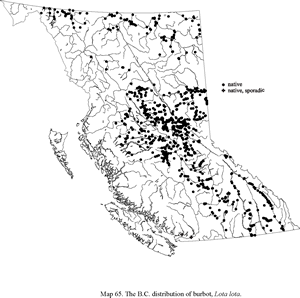Dorsal spines (total): 0; Dorsal soft rays (total): 67 - 96; Anal spines: 0; Anal soft rays: 58 - 79; Vertebrae: 50 - 67. Distinguished by the long second dorsal fin, at least 6 times as long as the first, and a single barbel on the chin. Gill rakers short. First dorsal short; second dorsal and anal fins joined to caudal; pectorals short and rounded; caudal rounded , with 40 rays. Color is yellow, light tan to brown with a pattern of dark brown or black on the body, head and fins. Pelvic fins pale, others dark and mottled.
Source: FishBase. Cohen, D.M., T. Inada, T. Iwamoto and N. Scialabba 1990 FAO species catalogue. Vol. 10. Gadiform fishes of the world (Order Gadiformes). An annotated and illustrated catalogue of cods, hakes, grenadiers and other gadiform fishes known to date. FAO Fish. Synop. 10 (125). 442 p.
